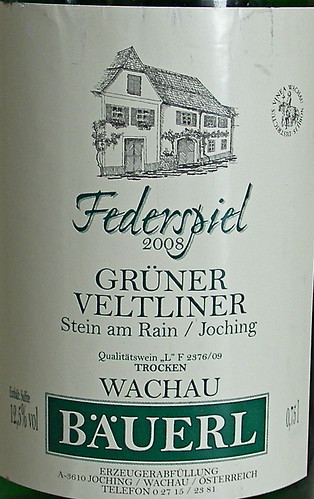 We had our first wine, the 2008 Bäuerl Stein am Rain Grüner Veltliner Federspiel with an appetizer of hungarian peppers. Grüner Veltliner is the most widely planted grape variety in Austria. Grüner means green in German as the grape tends to produce fresh and youthful wines. It grows well along the Danube river on steep, rocky river banks, as steep as those found in the Mosel wine region.
We had our first wine, the 2008 Bäuerl Stein am Rain Grüner Veltliner Federspiel with an appetizer of hungarian peppers. Grüner Veltliner is the most widely planted grape variety in Austria. Grüner means green in German as the grape tends to produce fresh and youthful wines. It grows well along the Danube river on steep, rocky river banks, as steep as those found in the Mosel wine region.Weingut Bäuerl is located in the Wachau, the part of the Danube valley between the village of Melks and Krems and one of Austria's westernmost wine-growing regions. The estate grows only white varieties: Grüner Veltliner (55%), Riesling (35%) and Muskateller (10%), and practices organic and sustainable viticulture. My notes: medium golden color, nose of green apple, pear, and honey. On the palate, smooth, juicy, and quite mineral. Good finish, nice appetite opener.
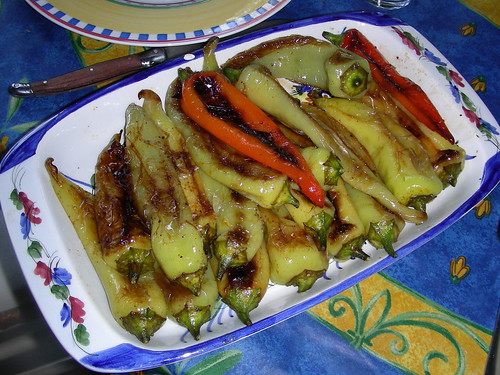
Hungarian Peppers
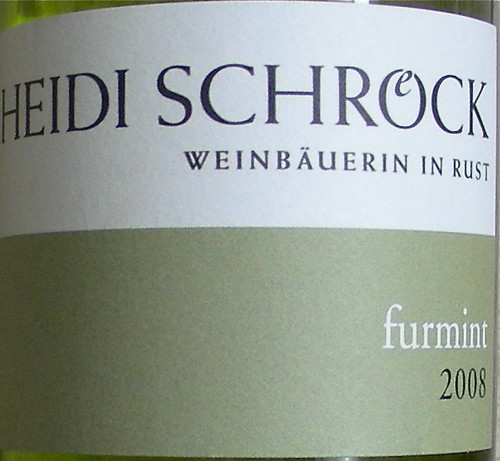 The next two wines were served with the sauerkraut. We started with the 2008 Heidi Schröck Ruster Furmint. Furmint is most widely grown in Hungary and is the main grape variety of Tokay, Hungary's famous dessert wine. It is also found in Austria's Burgenland, near the Hungarian border.
The next two wines were served with the sauerkraut. We started with the 2008 Heidi Schröck Ruster Furmint. Furmint is most widely grown in Hungary and is the main grape variety of Tokay, Hungary's famous dessert wine. It is also found in Austria's Burgenland, near the Hungarian border. Heidi Schröck is a small 8 hectare estate located in Rust, Burgenland, on the west side of Neusiedlersee. Neusiedlersee or Lake Neusiedl is the second largest steppe lake in Central Europe at the border of Austria and Hungary. The lake stores heat and regulates the region's climate. Thanks to warm and humid autumns, it also provides the best conditions for the production of botrytized dessert wines. My notes: this Furmint is actually completely dry. The wine is crisp, mineral with aromas of ripe apple and spices. Very distinctive and quite popular with the dinner guests.
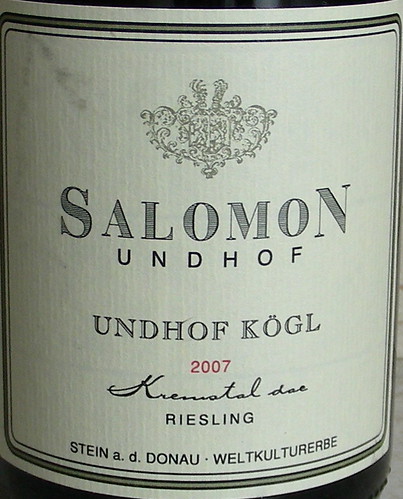 Also with the sauerkraut, we also tasted the 2007 Salomon Undhof Kögl Riesling. Founded in 1792, Salomon Undhof is a Wachau estate that produces white wines from the best terraced sites along the Danube River. The 25 hectares of Salomon Undhof's vineyards are planted with roughly half Riesling, half Grüner Veltliner. All the grapes are harvested traditionally by hand. Undhof Kögl is a south facing terraced single vineyard with highly weathered soil of crystalline schist bedrock. My notes: light color, acacia flowers, stone fruits on the nose. Dry, slightly fizzy on the palate, fresh and crisp with citrus flavors and spices on the finish. I thought it worked really well with the sauerkraut.
Also with the sauerkraut, we also tasted the 2007 Salomon Undhof Kögl Riesling. Founded in 1792, Salomon Undhof is a Wachau estate that produces white wines from the best terraced sites along the Danube River. The 25 hectares of Salomon Undhof's vineyards are planted with roughly half Riesling, half Grüner Veltliner. All the grapes are harvested traditionally by hand. Undhof Kögl is a south facing terraced single vineyard with highly weathered soil of crystalline schist bedrock. My notes: light color, acacia flowers, stone fruits on the nose. Dry, slightly fizzy on the palate, fresh and crisp with citrus flavors and spices on the finish. I thought it worked really well with the sauerkraut.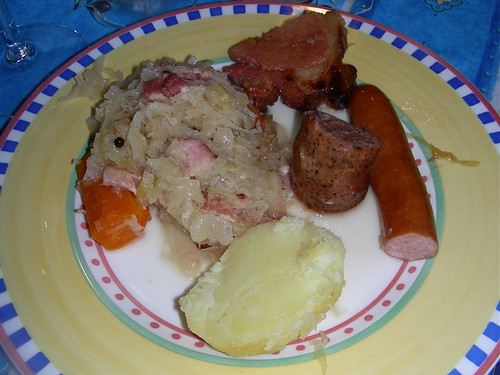
Our Sauerkraut
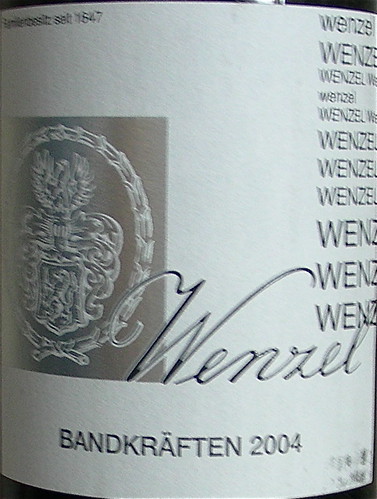 We had the next two reds with cheese and a berry pie. Our first red was the 2004 Wenzel Bandkraften Blaufränkisch. Weingut Wenzel is located in the Neusiedlersee-Hügelland wine-growing region. 60% of the 11 hectare vineyard is planted with the white varieties Furmint, Gelber Muskateller, Sauvignon Blanc, Pinot Gris, and Welschriesling, the remaining 40% is planted with the red varieties Blaufränkisch, Pinot Noir, and Merlot. Blaufränkisch is the second most important red grape variety in Austria after Zweigelt. It produces spicy wines rich in tannins. My notes: medium red color. Mocha and vanilla aromas on the nose. Full-bodiedood with wood and black cherry on the palate. Not as easy to drink as the next wine.
We had the next two reds with cheese and a berry pie. Our first red was the 2004 Wenzel Bandkraften Blaufränkisch. Weingut Wenzel is located in the Neusiedlersee-Hügelland wine-growing region. 60% of the 11 hectare vineyard is planted with the white varieties Furmint, Gelber Muskateller, Sauvignon Blanc, Pinot Gris, and Welschriesling, the remaining 40% is planted with the red varieties Blaufränkisch, Pinot Noir, and Merlot. Blaufränkisch is the second most important red grape variety in Austria after Zweigelt. It produces spicy wines rich in tannins. My notes: medium red color. Mocha and vanilla aromas on the nose. Full-bodiedood with wood and black cherry on the palate. Not as easy to drink as the next wine.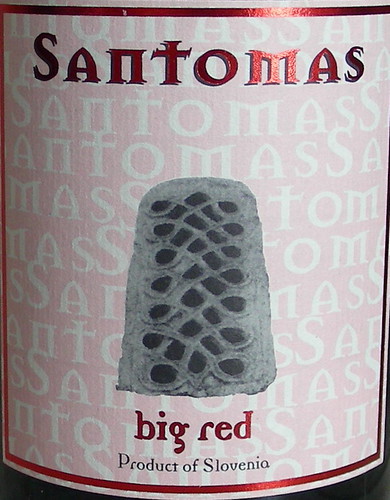 Our second red was the 2007 Santomas Big Red Refosk. Located in the village of Smarje in Slovenian Istria, just southeast of Trieste, Santomas is a family-owned winery overlooking the Adriatic Sea. The area is the warmest wine region in Slovenia so the local wine production is mostly red. The winery currently farms 19 hectares of vineyards planted with traditional varieties like Refosco and Istrian Malvasia, as well as international grapes like Cabernet Sauvignon and Merlot. Refosco is a Northern Italian red grape variety that mostly grows in Friuli, Gavi, and Trentino. In Slovenian Istria, it is also known as Refosk. The grape produce deep colored wines that can be quite powerful and tannic. My notes: dark purple color. Smoky nose with black cherry and blackberry aromas. Fruity with bright acidity on the palate. Quite popular with the cheese.
Our second red was the 2007 Santomas Big Red Refosk. Located in the village of Smarje in Slovenian Istria, just southeast of Trieste, Santomas is a family-owned winery overlooking the Adriatic Sea. The area is the warmest wine region in Slovenia so the local wine production is mostly red. The winery currently farms 19 hectares of vineyards planted with traditional varieties like Refosco and Istrian Malvasia, as well as international grapes like Cabernet Sauvignon and Merlot. Refosco is a Northern Italian red grape variety that mostly grows in Friuli, Gavi, and Trentino. In Slovenian Istria, it is also known as Refosk. The grape produce deep colored wines that can be quite powerful and tannic. My notes: dark purple color. Smoky nose with black cherry and blackberry aromas. Fruity with bright acidity on the palate. Quite popular with the cheese.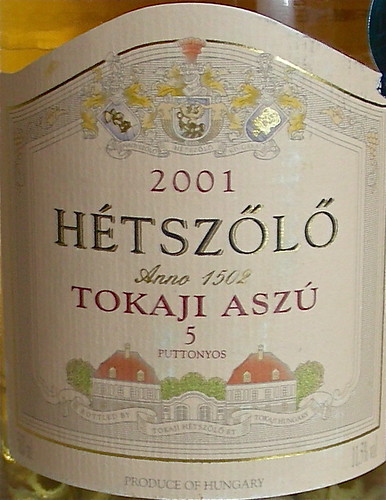 Our last wine was the 2001 Hétszölö Tokaji Aszu 5 Puttonyos. The Tokaji wine region, in northeastern Hungary, is characterized by long, warm autumns and misty mornings that favor the development of noble rot. The botrytis-infected grapes called Aszú are harvested manually, one grape at a time. They are then crushed and added to a dry base wine. The proportion of Aszú grapes added to the base wine is measured in puttonyos or baskets. One puttony represents 30 kilos of grapes that are poured into a traditional 126 liter barrel of base wine. The number of puttonyos can vary from 3 to 6 (the highest being the sweetest). The wine is then aged for three years in oak barrels stored in underground cellars. My notes: the Aszú 5 Puttonyos is 90 to 100% Furmint and has a minimum of 120 g/l of residual sugar. Deep golden color. Fresh, fragrant nose of apricot and tropical fruit. On the palate, unctuous texture with lively acidity, zesty kumquat notes on the finish.
Our last wine was the 2001 Hétszölö Tokaji Aszu 5 Puttonyos. The Tokaji wine region, in northeastern Hungary, is characterized by long, warm autumns and misty mornings that favor the development of noble rot. The botrytis-infected grapes called Aszú are harvested manually, one grape at a time. They are then crushed and added to a dry base wine. The proportion of Aszú grapes added to the base wine is measured in puttonyos or baskets. One puttony represents 30 kilos of grapes that are poured into a traditional 126 liter barrel of base wine. The number of puttonyos can vary from 3 to 6 (the highest being the sweetest). The wine is then aged for three years in oak barrels stored in underground cellars. My notes: the Aszú 5 Puttonyos is 90 to 100% Furmint and has a minimum of 120 g/l of residual sugar. Deep golden color. Fresh, fragrant nose of apricot and tropical fruit. On the palate, unctuous texture with lively acidity, zesty kumquat notes on the finish.Technorati tags: wine food & drink
No comments:
Post a Comment